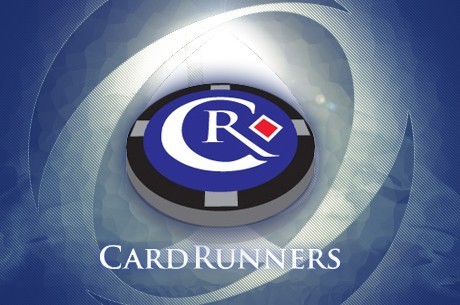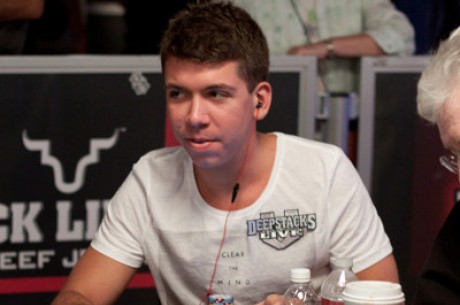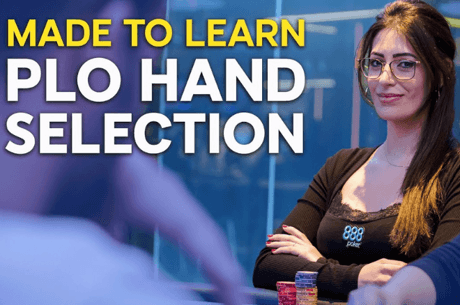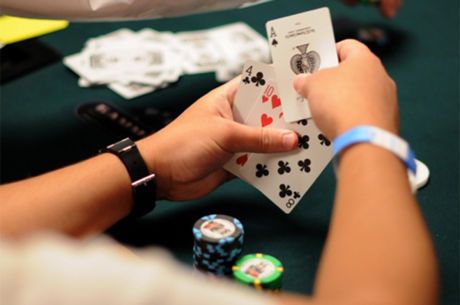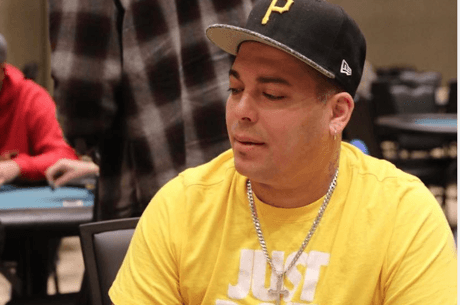Eric Crain Explains Hand Equity and Bluffing in Omaha Hi-Low 8-or-Better
Event #20: $1,500 Omaha Hi-Low 8-or-Better kicked off Monday at the 2013 World Series of Poker. Also known simply as O/8, Omaha Hi-Low 8-or-Better is a split-pot game in which the highest hand splits the pot with the lowest qualifying low hand. To qualify for the low half of the pot, the low hand must be 8,7,6,5,4 or lower, and the object for players is to "scoop" the entire pot.
PokerNews' Sarah Grant caught up with O/8 expert Bryan Devonshire on Monday to explain some of the basic concepts and strategies for tournament play. Devonshire discussed hand selection, raising for value, and equity. You can find the interview in the video below:
To expand further on O/8 hand equity and other advanced concepts, we grabbed Eric Crain, a two-time finalist already at this year's WSOP. He took fourth place in the $2,500 Eight-Game Mix, and just three days later finished sixth in the $1,500 Pot-Limit Hold’em event, collecting a combined $93,000 between the two events.
Here's what Crain had to say about O/8 tournament play:
PokerNews: As far as preflop ranges go, are there any hands that dominate other holdings or do equities run close?
Crain: In Omaha 8-or-Better, because it’s a split-pot game, you’re more liable to make the nuts that are going to hold up with low hands. You’re going to see a lot of people with the Ax2x3x4x and what not, and sticking to those hands. You know, the best piece of advice I ever got in O/8 was stick to one-two-three-four and you’re going to be fine. It’s true you know. You’ll see a lot of people try to get fancy with like ace-four and ace-five and those are the ones that end up in tricky situations and losing situations.
So it’s fair to say that Omaha split is a preflop and flop game and once you get to the turn and river you’re value betting rather than trying to chase people off a hand?
Exactly. A lot of times when you’re making the nut-low — let’s say you have an ace-deuce — well if a lot of people are seeing the flops then there are going to be a lot of aces and deuces out. So then, it’s going to be harder for your low hand to get counterfeited a lot of the time. So on later street’s it’s just a lot of value betting, and a lot of keeping the ace-fives and ace-sixes in the hand where those players will end up pretty much praying to win half the pot.
Do you calculate equity post-flop during a hand or do you already know the math?
I’m actually not great with the math of O/8. I mean I know what I need to be doing in what situations but if you asked me, ‘does this hand have 37 percent equity,’ then I’m just going to smirk and shrug and hope that I get it right.
So then for a player similar to you who is not familiar with the exact numbers, how do you roughly calculate the equity? Is it similar to Hold’em where you can use the 4/2-rule (calculate your outs 4x on the flop and 2x on the turn)?
It’s kind of similar to that but a lot of times there’s kind of a card removal aspect. If there are a lot of people seeing a flop then you can remove the aces from the deck, and not expect certain cards to come like deuces and what not. If it folds to me and I have 2x3x4x9x then I’m almost always raising obviously and I would consider a four-bet because if it folds all the way to me then I can assume that a lot of the aces are alive. Even though I just have that 2x3x4x then I can assume an ace will flop a lot of the time and make the nut-low with hopefully a redraw to the scoop.
How then do you gain edge on an opponent? Is it by position, bet sizing, etc.?

Like in any poker game position is obviously – it’s not the end all be all – but it’s very close. If I get Ax2x3x4x under the gun then I would limp instead of raise because I want to let the worse low draws get in the hand. If I have the same hand on the button and it’s been raised with like four callers then I’m not really jamming because again, I assume that a lot of those cards are already out. But if I had KxQxJx10x in the same position then I’m going to blast it.
So is having a Broadway hand safe to play if all you can get is a high hand?
The thing is if you are making Broadway with those hands then there won’t be a low to hand out very often. Is it safe to play if there aren’t many people in the hand? I would say not really because a lot of the low cards are still left. Whereas if it were multi-way action preflop then I feel you’re a pretty good favorite with that hand because again, low-cards are gone.
On what streets are your most crucial decisions made?
The flop is where most of your decisions will be made in O/8 because there are a lot of people who will chase back-door low draws if the pot is kept small. Let’s say you’re playing 300/600 then it’s only 300 to make the low. No it’s not. It’s going to be 300 plus the 600, so you’re committing 900 chips to win you know maybe 600 chips in the pot. You’re just not getting the odds to do that. A lot of people can talk themselves into really chasing but all that will happen is they’ll end up losing all their chips more quickly.
What do you consider to be a good amount of equity to continue with your hand after the flop?
In Omaha you want to be drawing to the nuts. You don’t want to be drawing to the fourth best low, especially if there are multiple people in the pot. If it’s heads-up you can be more creative about what hands you can draw to but when its three, four, or even five-handed you just have to be drawing to the nuts. Otherwise, you’ll find yourself sticking in a lot of bets and drawing completely dead.
Let’s say you have 2x3x in your hand and the board is 4x5x. Then you are only drawing to the ace?
Yes, you are absolutely only drawing to the ace. If the six peels off, especially if there are a few players in the hand, then there are Ax7x3x hands that will be available, even Ax2x3x or 7x8x where you can get quartered. That is a tricky one because you will see people go nuts with that hand. And again, if there are a lot of people in preflop then there won’t be a lot of live aces. It looks good but in reality it will cost you a lot of money. Even if you are drawing to two outs to scoop and on the board you hit the 8x you think well now I have the low and have to call down with a low and a lot of times you cost yourself more chips with a hand like that. It’s a compounding mistake.
Is having a straight more important than drawing to a flush?
It depends what the texture of the board is. If I already have the low, I would like to also have the flush draw with it. That way you’ll get the people with the straights and blast them. If you’ve got the freeroll with the nut-low and the flush draw — for example if I have the nut-straight — then that is a different story. A lot of times if there is a low on the board it is going to be hard to make the nut-straight and not have someone else have a redraw.
Is there any chance to steal pots post flop?
Of course. If it comes Jx10x9x and the guy is coming in firing and there is a good chance that he has a low hand, then there is an opportunity to steal. Of course though, you are playing with other people that know you are trying to steal so they might call down a little bit lighter. A lot of times especially against amateurs, if they bet even aces and see that flop and you raise they just kind of shrug and throw it away. As far as three-betting, if it’s that kind of board and they have aces they are never three-betting. They will either get married to their aces and call down or fold when you raised.
How many players maximum would have to be in a hand for you to attempt a bluff?
I had a hand earlier today where the board was 7x8♣9x with three people in the hand. I had Ax2x4x6x. It checked around on the flop. The turn was a 10♣, I didn’t have clubs, but it checked to me again and I was third to act. So I figured they all had low cards so I ended up betting. It was unlikely they had a straight because I would have heard from a straight either on the flop or turn. If not, then I had the low-draw. If I missed and the board ran any card that’s not a low then I feel a lot of times I can bet and pick it up there. It’s a board that supposed to connect to something that can beat one pair so you can pick it up. In general bluffing into three people will lose you a lot of money but in certain situations it can work out.
For more poker strategy, make sure to tune in every week for new episodes of the Strategy with Kristy podcast. Feel free to send in questions, ideas or suggestions for the podcast to kristy@pokernews.com. Also remember to follow PokerNews on Twitter for up-to-the-minute news.


